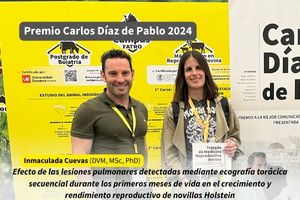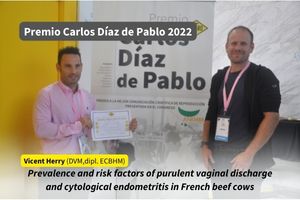
I. Cuevas-Gómez1, L. Molina2, J.M. Sánchez3
1Departmento de Reproducción Animal, Instituto Nacional de Investigación y Tecnología Agraria y Alimentaria, Madrid 28040, España.
2Rusama Ganadería S.L, Pozoblanco 14400, España.
3Instituto Andaluz de Investigación y Formación Agraria, Pesquera, Alimentaria y de la Producción Ecológica (IFAPA), Hinojosa del Duque 14270, España.
Bovine respiratory disease (BRD) during early life of dairy calves can impact their subsequent productive stages. Despite the significance of BRD, there is no gold standard diagnosis, and its effects extend beyond visible clinical signs. In fact, we previously reported that up to 64% of dairy calves may develop lung consolidation before weaning, with only 43% exhibiting clinical sings associated with BRD. Thoracic ultrasound scoring (TUS) has been recently validated as an accurate method for detecting BRD-related lung consolidation.
However, existing studies using TUS in preweaned dairy calves have predominantly relied on a single TUS record, limiting the assessment of persistent lung consolidation over time and potential recovery after BRD treatment. We hypothesized that persistent lung consolidation during early life of calves could negatively affect the subsequent growth and reproductive performance of heifers.
To our knowledge, this is the first study using sequential TUS to assess how lung consolidation during early stages of calf development affect growth and reproductive outcomes of Holstein heifers. The main objective of this longitudinal observational study was to determine whether persistent lung consolidation, detected using sequential TUS, was associated with average daily gain (ADG), age at first artificial insemination (AGE_AI), pregnancy rate at first AI (PR_1AI), and age at pregnancy achievement (AGE_PREG). Additionally, we aimed to investigate whether antibiotic treatment could reverse the potential consequences of lung consolidation. A total of 120 preweaned dairy calves from two commercial farms were included in the study. Five consecutive assessments of TUS, individual body weight, and rectal temperature were performed in each calf every 15 days by the same veterinarian, starting from 35.9 ± 5.4 days up to 98.4 ± 9.2 days of age. The TUS assessment covered the right 2nd through 10th and left 3rd through 9th intercostal spaces and was performed using an 8-MHz linear transducer.
Lung consolidation threshold was set at ≥1 cm2. Calf body weights were evaluated using a weight tape. Of note, calves with lung consolidation ≥3 cm2 or those with lung consolidation ≥2 cm2 and rectal temperature ≥38.9ºC or ≥39.1ºC during non-warm months or warm months, respectively, received antibiotic treatment. Heifers became eligible for AI upon reaching 55% of the adult live weight and a height at the withers of 135 cm.
AI was performed following visual estrus detection, and pregnancy diagnosis was performed by transrectal ultrasonography at 29 days post-AI. Statistical analysis comprised 600 TUS from 120 calves and the experimental unit was the calf. The number of evaluations with observed lung consolidation (NUMBER_CON) was categorized (0 vs ≥1). Persistent lung consolidation (PERSISTENT_CON) was defined when lung consolidation was observed in three consecutive evaluations. Recovery after antibiotic treatment (RECOVERY) was defined when no lung lesion was detected in the subsequent TUS after treatment.
Different multivariable, mixed-effects models were constructed (SAS software) for NUMBER_CON, PERSISTENT_CON, and RECOVERY, including farm as a covariate variable, to determine their association with ADG, AGE_AI, PR_1AI, and AGE_PREG. The results are presented in the Table (data represented as mean ± SD). In this study, 81.7% of calves showed lung consolidation at any point over the study and 18.3% exhibited persistent lung consolidation. Out of the total animals, 83.3% required antibiotic treatment, while 16.7% did not. From those treated calves, 50% recovered and 44% did not. NUMBER_CON was not associated with any of the variables analyzed. However, heifers with persistent lung consolidation showed reduced ADG (-88.2 g/day). Moreover, although PERSISTENT_CON was not associated with AGE_AI, pregnancy rate at first AI was lower in heifers with persistent lung consolidation, resulting in a delayed age at pregnancy (33.4 days later). Interestingly, heifers that did not recover after antibiotic treatment tended to be inseminated for the first time 14.8 days later and achieve pregnancy 28.2 days later than heifers that did not need treatment. In conclusion, persistent lung consolidation impairs calf growth, with a subsequent impact on pregnancy success that delay the age at the first pregnancy.
| %
(n) |
ADG (g/day) | P-value | AGE_AI (days) | P-value | PR_1AI (%) | P-value | AGE_PREG (days) | P-value | ||
| NUMBER_CON | 0 | 18.3 (22/120) | 846.0 ± 141.8 | >0.05 | 424.0 ± 34.5 | >0.05 | 61.9 | >0.05 | 440.0 ± 51.3 | >0.05 |
| ≥1 | 81.7 (98/120) | 823.4 ± 165.9 | 427.8±28.6 | 57.8 | 457.8 ± 57.5 | |||||
| PERSISTENT_CON | NO | 81.7 (98/120) | 843.7 ± 139.4 | 0.018 | 426.6±29.4 | >0.05 | 63.7 | 0.028 | 448.5 ± 47.5 | 0.026 |
| YES | 18.3 (22/120) | 755.5 ± 226.5 | 429.1±31.2 | 35.0 | 481.9 ± 83.0 | |||||
| RECOVERY | Non-treated | 16.7 (20/120) | 871.7 ± 126.1 | >0.05 | 416.2a±32.2 | 0.097 | 55.0 | >0.05 | 435.2a ± 53.6 | 0.054 |
| Recovered | 50 (50/100) | 835.6 ± 138.3 | 426.6a,b±26.4 | 64.4 | 450.8a,b ± 40.2 | |||||
| Non-recovered | 44 (44/100) | 799.7 ± 197.3 | 431.0b±28.9 | 52.5 | 463.4b ± 66.0 |
Accede para ver todo el contenido



